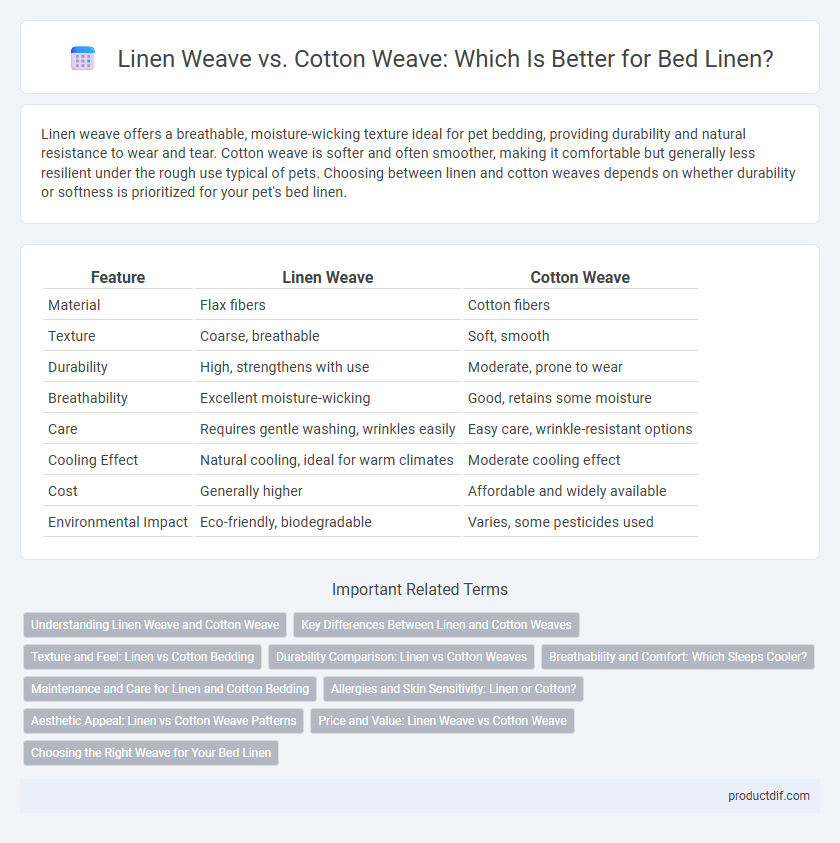Linen weave offers a breathable, moisture-wicking texture ideal for pet bedding, providing durability and natural resistance to wear and tear. Cotton weave is softer and often smoother, making it comfortable but generally less resilient under the rough use typical of pets. Choosing between linen and cotton weaves depends on whether durability or softness is prioritized for your pet's bed linen.
Table of Comparison
| Feature | Linen Weave | Cotton Weave |
|---|---|---|
| Material | Flax fibers | Cotton fibers |
| Texture | Coarse, breathable | Soft, smooth |
| Durability | High, strengthens with use | Moderate, prone to wear |
| Breathability | Excellent moisture-wicking | Good, retains some moisture |
| Care | Requires gentle washing, wrinkles easily | Easy care, wrinkle-resistant options |
| Cooling Effect | Natural cooling, ideal for warm climates | Moderate cooling effect |
| Cost | Generally higher | Affordable and widely available |
| Environmental Impact | Eco-friendly, biodegradable | Varies, some pesticides used |
Understanding Linen Weave and Cotton Weave
Linen weave is a plain weave structure made from flax fibers, characterized by its strength, breathability, and natural texture, making it ideal for durable and moisture-wicking bed linen. Cotton weave, often plain or sateen, uses fine cotton fibers that provide softness, smoothness, and a more uniform surface, enhancing comfort and easy care. Understanding the differences in fiber properties and weave patterns between linen and cotton helps in selecting bed linen that balances durability, breathability, and tactile experience.
Key Differences Between Linen and Cotton Weaves
Linen weave features a plain weave structure with thicker, uneven fibers that create a textured, breathable fabric known for durability and moisture-wicking properties. Cotton weave typically uses finer, uniform threads woven tightly, resulting in a smoother, softer fabric with less texture and enhanced softness for everyday bed linen comfort. Key differences include linen's coarse texture and superior airflow versus cotton's smooth finish and gentle feel on the skin.
Texture and Feel: Linen vs Cotton Bedding
Linen weave bedding features a coarser texture with a naturally slubby surface that offers a breathable, crisp feel ideal for warm climates. Cotton weave provides a smoother, softer texture with a finer surface, delivering a plush, cozy sensation suitable for year-round comfort. The inherent properties of linen create a more textured and durable fabric, while cotton maintains a gentle touch and excellent moisture absorption.
Durability Comparison: Linen vs Cotton Weaves
Linen weave offers superior durability compared to cotton weave due to the natural strength of flax fibers and a tighter, more rigid interlacing pattern, which resists wear and tear over time. Cotton weave, while softer and more flexible, tends to show signs of wear faster, including pilling and thinning, especially with frequent washing. For long-lasting bed linen, linen weave provides enhanced resilience and longevity, making it a preferred choice for durable bedding.
Breathability and Comfort: Which Sleeps Cooler?
Linen weave offers superior breathability compared to cotton weave due to its loosely woven fibers, allowing better air circulation and moisture-wicking properties that keep sleepers cooler. Cotton weave, while soft and comfortable, tends to retain more heat and moisture, making it less ideal for hot sleepers. Choosing linen weave bed linen enhances comfort by maintaining a cooler, drier sleeping environment, especially in warm climates.
Maintenance and Care for Linen and Cotton Bedding
Linen weave bedding requires gentle washing in cool water with mild detergent and should be air-dried or tumble dried on low heat to maintain its natural fibers and prevent shrinkage. Cotton weave bedding offers more resilience to frequent washing and higher temperatures, making it easier to maintain with regular machine washing and tumble drying. Both fabrics benefit from ironing while damp to preserve texture, but linen's durability increases with age and proper care, whereas cotton may gradually lose softness.
Allergies and Skin Sensitivity: Linen or Cotton?
Linen weave is naturally hypoallergenic and highly breathable, making it ideal for sensitive skin and allergy sufferers due to its moisture-wicking and antibacterial properties. Cotton weave, while soft and widely used, can retain more allergens and moisture, potentially aggravating sensitive skin or allergies over time. Choosing linen weave bed linen can reduce skin irritation and promote a healthier, allergen-free sleep environment.
Aesthetic Appeal: Linen vs Cotton Weave Patterns
Linen weave exhibits a distinctive, slightly textured surface with natural slubs that create a rustic, elegant aesthetic often sought in premium bed linen. Cotton weave, particularly in sateen or percale, offers a smoother, more uniform appearance that enhances the crisp and clean look of bedding. The inherent irregularities in linen weave provide a casual, organic charm, while cotton weave patterns emphasize precision and soft sheen for a polished bedroom style.
Price and Value: Linen Weave vs Cotton Weave
Linen weave tends to be more expensive than cotton weave due to the labor-intensive process of harvesting flax fibers and the material's natural durability, offering long-term value despite the higher upfront cost. Cotton weave provides a more affordable option with softer texture and easier maintenance but may wear out faster compared to linen. Investing in linen weave results in enhanced longevity and breathability, making it a cost-effective choice for premium bed linen over time.
Choosing the Right Weave for Your Bed Linen
Linen weave offers a distinctive texture and breathability, making it ideal for hot sleepers and warm climates, while cotton weave provides a soft, smooth finish with excellent durability and easy care. Choosing the right weave for your bed linen depends on personal comfort preferences, climate, and maintenance requirements; linen excels in moisture-wicking and longevity, whereas cotton excels in softness and affordability. Both weaves vary in thread count and fiber quality, influencing the overall feel and lifespan of your bedding.
Linen Weave vs Cotton Weave Infographic

 productdif.com
productdif.com